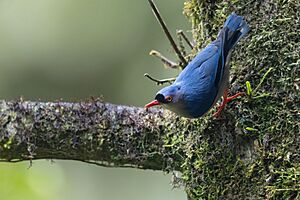Velvet-fronted nuthatch facts for kids
Quick facts for kids Velvet-fronted nuthatch |
|
|---|---|
 |
|
| Male with black stripe above and behind eye, in Sabah, Malaysia |
|
| Conservation status | |
| Scientific classification | |
| Genus: |
Sitta
|
| Species: |
frontalis
|
The velvet-fronted nuthatch (Sitta frontalis) is a small passerine bird. It belongs to the nuthatch family, called Sittidae. You can find this bird in southern Asia. Its home ranges from Nepal, India, Sri Lanka, and Bangladesh all the way east to southern China and Indonesia.
Like other nuthatches, this bird eats insects. It finds them in the bark of trees. It looks for food on tree trunks and branches. Its strong claws help it climb down trees head-first. It can also move on the underside of branches. These birds live in forests with lots of trees. They often join other bird species in mixed-species foraging flocks to find food. Male velvet-fronted nuthatches have a black stripe above and behind their eyes. They make a fast, chipping sound. They build their nests in holes in trees. These holes are often made by woodpeckers or barbets.
Contents
What Does the Velvet-Fronted Nuthatch Look Like?
The velvet-fronted nuthatch has the usual nuthatch shape. It has a short tail and a strong beak and feet. This bird is about 12.5 centimeters (5 inches) long. Its back is a pretty violet-blue color. Its cheeks are lavender, and its belly is beige. It has bright yellow eyes and a whitish throat.
Its beak is red. There is a black patch on its forehead and near its eyes. This patch is bigger and darker in adult birds. Young birds have a dark beak. They also have dark tips on the feathers under their tail. Adult males have a special black stripe. This stripe goes above their eye and over their head towards their neck.
Female nuthatches do not have this black stripe. Their underparts are also a warmer color. Young birds look duller than adults. They do not have the black patch on their forehead. Different groups of these birds can look slightly different. They might vary in color shade or size. The amount of white on their throat can also differ.
Where Do Velvet-Fronted Nuthatches Live?
The velvet-fronted nuthatch lives in many types of forests. These include forests that lose their leaves (deciduous) and those that stay green all year (evergreen). In the Sunderbans area, they even live in mangrove forests. They can also be found in forests that have grown back after being cut down. Sometimes, they live in the shade trees of coffee farms in southern India.
Like other nuthatches, they have strong, curved claws. These claws let them climb down tree trunks head-first. This is different from birds like woodpeckers, which usually only climb upwards. The nuthatch moves quickly up, down, or around tree branches and trunks. It actively searches for insects and spiders. It picks them off the bark of trunks and branches. You might see it in mixed groups of birds looking for food. Sometimes, the Greater racket-tailed drongo in Sri Lanka catches insects that the nuthatch disturbs.
This bird is quite noisy. You can often find it by its repeated "sit-sit-sit" call.
Reproduction and Life Cycle
Nests are built in holes or cracks in trees. The birds line these nests with moss, fur, feathers, or grass. In northern India, the breeding season is in summer, from April to June. In southern India and Sri Lanka, it's from January to May. Unlike some other nuthatches, this species does not use mud to make the nest hole smaller.
The female lays three to six eggs. These eggs are white with red speckles. The female spends more time sitting on the eggs to keep them warm. But both parents take turns feeding the young birds once they hatch.
Velvet-Fronted Nuthatches in Culture
Since this is a small forest bird, only a few forest tribes know about it. The Lotha Naga people hunt many birds for food. However, they generally do not hunt the velvet-fronted nuthatch. They believe that killing these birds would bring bad luck to the hunter. They think that if one bird is killed, the others in the flock will stay nearby. The Lothas believe these birds will wait to be killed. They think the hunter would then see people around them die quickly, one after another. The Soliga people call this bird the "maratotta," which means "tree hopper."
Images for kids




